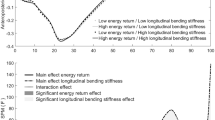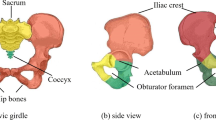Abstract
The present paper describes a shape optimization procedure for designing running shoes, focusing on two mechanical properties, namely, the shock absorption and the stability keeping the right posture. These properties are evaluated from two deformations of a sole at characteristic timings during running motion. We define approximate planes for the deformations of sole’s upper boundary by least squares method. Using the planes, we choose the tilt angle in the shoe width direction at the mid stance phase of running motion as an objective function representing the stability, and the sunk amount at the contact phase of running motion as a constraint function representing the shock absorption. We assume that the sole is a bonded structure of soft and hard hyper-elastic materials, and the bonding and side boundaries are variable. In this study, we apply the formulation of nonparametric shape optimization to the sole considering finite deformation and contact condition of the bottom of the sole with the ground. Shape derivatives of the cost (objective and constraint) functions are obtained using the adjoint method. The H1 gradient method using these shape derivatives is applied as an iterative algorithm. To solve this optimization problem, we developed a computer program combined with some commercial softwares. The validity of the optimization method is confirmed by numerical examples.









Similar content being viewed by others
References
Areblad M, Nigg BM, Ekstrand J, Olsson KO (1990) Three-dimensional measurement of rearfoot motion during running. J Biomech 23:933–940
Azegami H (2016) Shape optimization problems (in Japanese). Morikita Publishing, Tokyo
Azegami H (2017) Solution of shape optimization problem and its application to product design. In: Itou H, Kimura M, Chalupecký V, Ohtsuka K, Tagami D, Takada A (eds) Proceedings of the international conference CoMFoS15 Mathematical analysis of continuum mechanics and industrial applications, Springer Singapore, Mathematics for industry, 26: 83–98. https://doi.org/10.1007/978-981-10-2633-1
Azegami H, Takeuchi K (2006) A smoothing method for shape optimization: Traction method using the Robin condition. Int J Comput Methods 3(1):21–33
Azegami H, Wu ZQ (1996) Domain optimization analysis in linear elastic problems: Approach using traction method. JSME Int J Ser A 39(2):272–278
Cardoso JB, Arora JS (1988) Variational method for design sensitivity analysis in nonlinear structural mechanics. AIAA J 26:595– 603
Cavanagh P (1980) The running shoe book. Anderson World, California
Choi KK, Chang KH (1994) A study on the velocity computation for shape design optimization. J Finite Elem Anal Des 15:317–347
Clarke TE, Frederick EC, Cooper LB (1983) Effects of running shoes on ground reaction forces. Int J Sports Med 4:247–251
Dassault Systèmes (2018) Abaqus Analysis User’s Guide 2018. Vélizy-Villacoublay
Delfour MC, Zolésio JP (2011) Shapes and geometries: Metrics, analysis, differential calculus and optimization, 2nd edn. Society for Industrial and Applied Mathematics, Philadelphia
Gard SA, Konz RJ (2004) The effect of a shock-absorbing pylon on the gait of persons with unilateral transtibial amputation. J Rehabil Res Dev 40:109–124
Gibson LJ, Ashby MF (1980) Cellular solids structure and properties, Cambridge University Press, Cambridge, England
Hisada T (1995) Recent progress in nonlinear fem-based sensitivity analysis. JSME Int J 38:301–310
Ihara H, Azegami H, Shimoda M (1999) Solution to shape optimization problems considering material nonlinearity. Comput Aided Opt Des Struct 40:87–95
Iwai T, Sugimoto A, Aoyama T, Azegami H (2010) Shape optimization problem of elastic bodies for controlling contact pressure. JSIAM Lett 2:1–4
Kaneko I, Majer G (1981) Optimal design of plastic structures under displacement constraints. Comput Methods Appl Mech Engrg 27:369–391
Kim NH, Choi KK, Chen JS (2000) Shape design sensitivity analysis and optimization of elasto-plasticity with frictional contact. AIAA J 398:1742–1753
Matheson GO, Clement DB, Makenzie DC, Taunton J, Lioyd-Smith D, Maclntyre JG (1987) Stress fractures in athletes: A study of 320 cases. Am J Sports Med 15:46–68
Mills NJ (2007) Polymer foams handbook. Butterworth-Heinemann, Oxford
Nakabe N, Nishiwaki T (2002) Development of simplified numerical foot model for sole stability design. Eng Sport 4:824–830
Nigg BM (1980) Biomechanics of running shoes. Human Kinetics, Champaign, Illinois
Nigg B M, Bahlsen HA, Luethi SM, Stokes S (1987) The influence of running velocity and midsole hardness on external impact forces in heel-toe running. J Biomech 20:951–959
Nigg BM, Herzog W, Read LJ (1988) Effect of viscoelastic shoe insoles on vertical impact forces in heel-toe running. Am J Sports Med 16:70–76
Nishiwaki T (2008) Running shoe sole stiffness evaluation method based on eigen vibration analysis. Sports Technol 1:76–82
Oriwol D, Sterzing T, Milani TL (2011) The position of medial dual density midsole elements in running shoes does not influence biomechanical variables. Footwear Sci 3:107–116
Ryu YS, Haririan M, Wu CC, Arora JS (1985) Structural design sensitivity analysis of nonlinear response. Comput Struct 21:245–255
Stacoff A, Reinschmidt C, Stüssi E (1992) The movement of the heel within a running shoe. Med Sci Sports Exerc 24:695–701
Tanaka M, Noguchi H (2004) Structural shape optimization of hyperelastic material by discrete force method. Theor Appl Mech Japan 53:83–91
Tsay JJ, Arora JS (1990) Nonlinear structural design sensitivity analysis for path dependent problems, part1: General theory. Comput Methods Appl Mech Engrg 81:183–208
Vidal CA, Haber RB (1993) Design sensitivity analysis for rate-independent elastoplasticity. Comput Methods Appl Mech Engrg 107:393–431
Vidal CA, Lee HS, Haber RB (1991) The consistent tangent operator for design sensitivity analysis of history-dependent response. Comput Syst Engrg 2:509–523
Woensel WV, Cavanagh PR (1992) A perturbation study of lower extremity motion during running. Int J Sport Biomech 8:30–47
Yamazaki K, Shibuya K (1998) Sensitivity analysis of nonlinear material and its application to shape optimization. In: Collect Tech Pap AIAA/ASME/ASCE/AHS/ASC Struct Struct Dyn Mater Conf, pp 1706–1713
Yuge K, Kikuchi N (1995) Optimization of a frame structure subjected to a plastic deformation. Struct Optim 10:197–208
Author information
Authors and Affiliations
Corresponding author
Ethics declarations
Conflict of interest
The authors declare that they have no conflict of interest.
Additional information
Responsible Editor: Seonho Cho
Publisher’s note
Springer Nature remains neutral with regard to jurisdictional claims in published maps and institutional affiliations.
Replication of results
The results described in this paper can be replicated by implementing the formulas and algorithms described in this paper. Regarding the foot pressure distributions and material parameters for the sole model used in the numerical examples, the authors want to withhold its replication for commercial purposes.
Rights and permissions
About this article
Cite this article
Nonogawa, M., Takeuchi, K. & Azegami, H. Shape optimization of running shoes with desired deformation properties. Struct Multidisc Optim 62, 1535–1546 (2020). https://doi.org/10.1007/s00158-020-02560-0
Received:
Revised:
Accepted:
Published:
Issue Date:
DOI: https://doi.org/10.1007/s00158-020-02560-0




